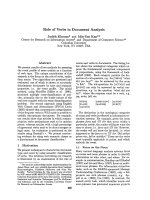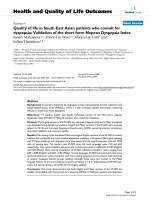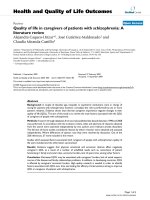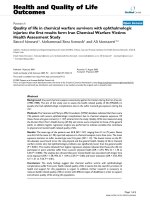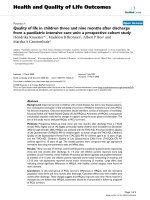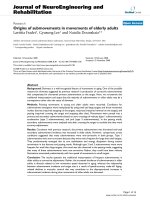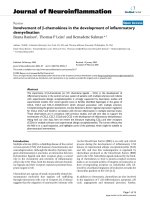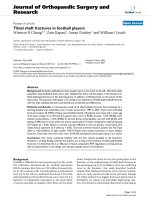Báo cáo hóa học: " Semistability of iterations in cone spaces" pot
Bạn đang xem bản rút gọn của tài liệu. Xem và tải ngay bản đầy đủ của tài liệu tại đây (225.66 KB, 8 trang )
RESEARC H Open Access
Semistability of iterations in cone spaces
A Yadegarnegad
1
, S Jahedi
2*
, B Yousefi
1
and SM Vaezpour
3
* Correspondence: jahedi@sutech.
ac.ir
2
Department of Mathematics,
Shiraz University of Technology, P.
O. Box: 71555-313, Shiraz, Iran
Full list of author information is
available at the end of the article
Abstract
The aim of this work is to prove some iteration procedures in cone metric spaces.
This extends some recent results of T-stability.
Mathematics Subject Classification: 47J25; 26A18.
Keywords: Cone metric, contraction, stability, nonexpan sive, affine, semi-compact
1. Introduction
Let E be a real Banach space. A subset P ⊂ E is called a cone in E if it satisfies in the
following conditions:
(i) P is closed, nonempty and P ≠ {0}.
(ii) a, b Î R, a, b ≥ 0 and x, y Î P imply that ax + by Î P.
(iii) x Î P and -x Î P imply that x =0.
The space E can be partially ordered by the cone P ⊂ E,bydefining;x ≤ y if and
only if y - x Î P, Also, we write x ≪ y if y - x Î int P, where int P denotes the interior
of P.AconeP is called normal if there exists a constant k >1suchthat0≤ x ≤ y
implies ||x|| ≤ k||y||.
In the following we suppose that E is a real Banach space, P is a cone in E and ≤ is a
partial ordering with respect to P.
Definition 1.1. ([1]) Let X be a nonempty set. Assume that the mapping d: X × X ®
E satisfies in the following conditions:
(i) 0 ≤ d(x, y) for all x, y Î X and d(x, y) = 0 if and only if x = y,
(ii) d(x, y)=d(y, x) for all x, y Î X.
(iii) d(x, y) ≤ d(x, z)+d(z, y) for all x, y, z Î X.
Then d is called a cone metric on X and (X, d) is called a cone metric space.
If T is a self-map of X,thenbyF(T) we mean the set of fixed points of T.Also,N
0
denotes the set of nonnegative integers, i.e., N
0
= N ∪ {0}.
Definition 1.2. ([2]) If 0 <a <1,0<b,
γ<
1
2
we say that a map T: X ® X is
Zamfirescu with respect to (a, b, g), if for each pair x, y Î X, T satisfies at least one of
the following conditions:
Z(1). d(Tx, Ty) ≤ ad(x, y),
Z(2). d(Tx, Ty) ≤ b(d(x, Tx)+d(y, Ty)),
Z(3). d(Tx, Ty) ≤ g (d(x, Ty)+d(y, Tx)).
Usually for simplicity, T is called a Zamfirescu operator if T is Zamfirescu with
respect to some (a, b, g), for some scalars a, b, g with above restrictions. Also, T is
Yadegarnegad et al. Fixed Point Theory and Applications 2011, 2011:70
/>© 2011 Yadegarnegad et al; licensee Springer. This is an Open Access article distributed under the terms of the Creative Commons
Attribution Lice nse (http://c reativecommons.org/licenses/by/2.0), which permits unrestricted use, distribution, and reproduction in
any medium, provided the original work is properly cited.
called a f-Zamfirescu operator if the relatio ns Z(1), Z(2) and Z(3) hold for all x Î X
and all y Î F(T).
Definition 1.3. ([3]) Let (X, d) be a cone metric space. A map T: X ® X is called a
quasi-contraction if for some constant l Î (0, 1) and for every x, y Î X,thereexists
u Î C(T; x, y) ≡ {d(x, y), d(x, Tx), d(y, Ty), d(y, Tx), d(x, Ty)} such that d(Tx, Ty) ≤
lu. If this inequality holds for all x Î X and y Î F(T), we say that T is
a f-quasi-
contraction.
Lemma 1.4.([4])IfT is a quasi-contraction with
0 <λ<
1
2
,thenT is a Zamfirescu
operator.
Lemma 1.5. ([4]) Let P be a normal cone, and let {a
n
}and{b
n
}besequencesinE
satisfying the inequality a
n+1
≤ ha
n
+ b
n
, where h Î (0, 1) and b
n
® 0asn ® ∞. Then
lim
n
a
n
=0.
Definition 1.6. A self-map T of a metric space (X, d) is called nonexpansive if d(Tx,
Ty) ≤ d(x, y) for all x, y Î X.
Definition 1.7.Aself-mapT of (X, d) is called affine if T(ax +(1-a)y)=aTx +
(1 -a)Ty for all x, y Î X,anda Î [0, 1].
Definition 1.8.Aself-mapT of (X, d) is called semi-compact if the convergence
||x
n
- Tx
n
||®0 implies that there exist a subsequence
{x
n
k
}
of {x
n
}andx* Î X
such that
x
n
k
→ x
∗
.
2. Main results
In this section we want to prove some iteration procedures in cone spaces. This
extends some recent results of T-stability ([4]). Khamsi [5] ha s shown that any normal
cone metric space can have a metric type defined on it. Consequently, our results are
consistent for any metric spaces. Let (X, d)beaconemetricspaceand{T
n
}
n
be a
sequence of self-maps of x with ∩
n
F(T
n
) ≠ ∅.Letx
0
beapointofX, and assume that
x
n+1
= f(T
n
, x
n
) is a n iteration procedure involving {T
n
}
n
, which yields a sequ ence {x
n
}
of points from X.
Definition 2.1. The iteration x
n+1
= f(T
n
, x
n
)issaid{T
n
}-semistable (or semistable
with respect to {T
n
}) if {x
n
} converges to a fixed point q in ∩
n
F(T
n
), and whenever {y
n
}
is a sequence in X with lim
n
d(y
n
, f (T
n
, y
n
)) = 0, and d(y
n
, f (T
n
, y
n
)) = o(t
n
)forsome
sequence {t
n
} ⊂ R
+
, then we have y
n
® q.
In practice, such a sequence {y
n
} could arise in the following way. Let x
0
be a point
in X.Setx
n+1
= f(T
n
, x
n
). Let y
0
= x
0
.Nowx
1
= f(T
0
, x
0
). Because of rounding or dis-
cretization in the function T
0
,anewvaluey
1
approximately equal to x
1
might be
obtained instead of the true value of f(T
0
, x
0
). Then to approximate y
2
, the value f(T
1
,
y
1
)iscomputedtoyieldy
2
, approximation of f(T
1
, y
1
). This computation is continued
to obtain {y
n
} as an approximate sequence of {x
n
}.
In the following we extend the definition of stability from a sing le self- map (see [6])
to a sequence of single-maps.
Definition 2.2. The iteration x
n+1
= f(T
n
, x
n
)issaid{T
n
}-stable (or stable with
respect to
{T
n
}
n∈N
0
)if{x
n
} converges to a fixed point q in ∩
n
F(T
n
), and whenever {y
n
}is
a sequence in X with lim
n
d(y
n+1
, f(T
n
, y
n
)) = 0, we have y
n
® q.
Note that if T
n
= T for all n, then Definition 2.2. gives the definition of
T-stability ([6]).
Yadegarnegad et al. Fixed Point Theory and Applications 2011, 2011:70
/>Page 2 of 8
Definition 2.3. For a sequence o f self-maps
{T
n
}
n∈N
0
,theiterationx
n+1
= T
n
x
n
is
called the Picard’s S-iteration.
The stability of some iterations have been studied in m etric spaces in [7,8]. Here we
want to investigate the semistability and stability of Picard’s S-iteration.
Theorem 2.4. Let (X, d) be a cone metric space, P a normal cone and {T
n
}
n
= N
0
be
asequenceofself-mapsofX with ∩
n
F(T
n
) ≠ ∅. Suppose that there exist nonnegative
bounded sequences {a
n
}, {b
n
} with sup
n
b
n
< 1, such that
d
(
T
n
x, q
)
≤ a
n
d
(
x, T
n
x
)
+ b
n
d
(
x, q
)(
*
)
for each n Î N
0
, x Î X and q Î ∩
n
F(T
n
). Then the Picard’ s S-iteration is semistable
with respect to {T
n
}
n
.
Proof. First we no te that relation (*) implies that ∩
n
F(T
n
) is a singleton. Indeed, if
p and q belong to ∩
n
F(T
n
), then by (*) we get
d(p, q)=d(T
n
p, q) ≤ a
n
d(p, T
n
p)+b
n
d(p, q) ≤ αd(p, q),
where a = sup
n
b
n
. This implies that p = q. So let ∩
n
F(T
n
)={q
0
} and {y
n
} ⊂ X be such
that lim
n
d(y
n+1
, T
n
y
n
) = lim
n
d(T
n
y
n
, y
n
) = 0. Now we show that y
n
® q
0
. For this by
using the relation (*) we have:
d(y
n+1
, q
0
) ≤ d(y
n+1
, T
n
y
n
)+d(T
n
y
n
, q
0
)
≤ d(y
n+1
, T
n
y
n
)+a
n
d(T
n
y
n
, y
n
)+b
n
d(y
n
, q
0
)
= c
n
+ αd(y
n
, q
0
),
where c
n
= d(y
n+1
, T
n
y
n
)+a
n
d(T
n
y
n
, y
n
) tends to 0 as n ® ∞,and0≤ a <1.Now
by Lemma 1.5, y
n
® q
0
and so the Picard’sS-iterationis{T
n
}
n
-semistable. This com-
pletes the proof.□
Corollary 2.5. Let (X, d) be a cone metric space, P a normal cone and
{
T
n
}
n∈N
0
be a
sequence of self-maps of X with ∩
n
F(T
n
) ≠ ∅. If there exists a nonnegative sequence
{l
n
}withsup
n
l
n
<1suchthatd(T
n
x, T
n
y) ≤ l
n
d(x, y)foreachx, y Î X and n Î N
0
,
then the Picard’s S-iteration is semistable with respect to {T
n
}
n
.
Corollary 2.6. Let (X, d) be a cone metric space, P a normal cone and
{T
n
}
n∈N
0
be a
sequence of self-maps of X with ∩
n
F(T
n
) ≠ ∅.Ifforalln Î N
0
, T
n
is a f-Zamfirescu
operator with respect to (a
n
, b
n
, g
n
)withsup
n
g
n
< 1/2, then the Picard’s S-iteration is
semistable with respect to {T
n
}
n
.
Proof. It is sufficient to show that condition (*) in Theorem 2.4 is consistent. Clearly
the conditions Z(1) and Z(2) imply that (*) holds. Also, note that by usin g condition Z
(3) for T
n
we have:
d(T
n
x, q) ≤ γ
n
(d(q, T
n
x)+d(x, q)),
where q Î ∩
n
F(T
n
). Thus we get
d(T
n
x, q) ≤ γ
n
d(x, T
n
x)+2γ
n
d(x, q).
Since sup
n
g
n
< 1/2, so clearly (*) holds.□
Corollary 2.7. Under the conditions of Corollary 2.6 if T
n
is a Zamfirescu operator
for all n, then the Picard’s S-iteration is semistable with respect to {T
n
}
n
.
Corollary 2.8.Let(X, d) be a cone metric space, P a normal cone and
{T
n
}
n∈N
0
be
asequenceofself-mapsofX with ∩
n
F(T
n
) ≠ ∅.Ifforalln Î N
0
, T
n
is a f-qu asi-
Yadegarnegad et al. Fixed Point Theory and Applications 2011, 2011:70
/>Page 3 of 8
contraction with l
n
such that sup
n
l
n
< 1, then the Picard’s S-iteration is semistable
with respect to {T
n
}
n
.
Proof. It is sufficient to show that condition (*) holds. For every x Î X and q Î ∩
n
F
(T
n
) we have d(T
n
x, q) ≤ g
n
u
n
for some u
n
Î C(T
n
; x, q). Hence
d(T
n
x, q) ≤ t
n
d(x, T
n
x)+s
n
d(x, q),
where s
n
, t
n
Î {0, l
n
}. This completes the proof. □
Theorem 2.9. Under the conditions of Theorem 2.4, suppose that there exists a
sequence of nonnegative scalars
{λ
n
}
n∈N
0
with sup
n
l
n
< 1/2, such that fo r all x, y Î X,
n ≥ 1wehaved(T
n
x, T
n-1
y) ≤ l
n
u
n
where u
n
= d(T
n
x, y)oru
n
= d(T
n-1
y, y). Then
the Picard’s S-iteration is semistable with respect to {T
n
}
n
.
Proof. It is sufficient to show that d(y
n
, T
n
y
n
) ® 0wheneverd(y
n+1
, T
n
y
n
) ® 0. Put
b
n
= d(y
n
, T
n
y
n
) and c
n
= d(y
n
, T
n-1
y
n-1
). We have
b
n
≤ d(y
n
, T
n−1
y
n−1
)+d(T
n
y
n
, T
n−1
y
n−1
) ≤ c
n
+ s
n
b
n−1
,
where s
n
= l
n
or
s
n
=
λ
n
1−λ
n
. Hence by Lemma 1.5, b
n
® 0, and so by the proof of
Theorem 2.4, the proof is complete.□
Now we want to investigate the semistability in the cone normed spaces.
Definition 2.10.LetX b e a vector space over the field F. Assume that the function
p: X ® E having the properties:
(a) p(x) ≥ 0 for all x in X.
(b) p(x + y) ≤ p(x)+p(y) for all x, y in X.
(c) p(ax)=|a|p(x) for all a Î F and x Î X.
Then p is called a cone seminorm on X. A cone norm is a cone seminorm p such
that
(d) x =0ifp(x)=0.
We will denote a cone norm by ||·||
c
and (X, ||·||
c
) is called a cone normed space.
Also, d
c
(x, y)=||x - y||
c
defines a cone metric on X.
Lemma 2.11. Let P be a normal cone, and the sequences {t
n
} and (s
n
} be such that 0
≤ t
n+1
≤ t
n
+ s
n
for all n ≥ 1. If ∑
nÎN
s
n
converges, then lim
n
||t
n
|| exists.
Proof. Let t
1
= 0 and P be normal with constant k. Since t
n+1
- t
n
≤ s
n
, thus ∑
n
(t
n+1
-
t
n
) ≤∑
n
s
n
. Hence ||∑
n
(t
n+1
- t
n
)|| ≤ k ||∑
n
s
n
|| < ∞.So
lim
k
k
n=1
(t
n+1
− t
n
)
exists.
But
k
n=1
(t
n+1
− t
n
)=t
k+1
− t
1
. Thus indeed lim
n
||t
n
|| exists.□
Theorem 2.12. Let (X,||·||
c
) be a cone normed sp ace with respect to a normal cone
P in the real Banach space E ,and
{T
n
}
n∈N
0
beasequenceofself-mapsofX with ∩
n
F
(T
n
) ≠ ∅, T
0
= I and d
c
(T
n
x, q) ≤ (1 + a
n
) d
c
(x, q)foralln Î N
0
, x Î X and q Î ∩
n
F
( T
n
)where
n∈N
0
α
n
< ∞
. Suppose that t here exists a sequence {b
n
} ⊂ (0, 1] such
that
n
1−β
n
n
< ∞
and the sequence {x
n
}
n
obtaine d by the iteratio n procedure x
n+1
=
b
n
x
n
+(1-b
n
)S
n
x
n
be bounded where
S
n
=
1
n
(T
0
+ T
1
+ ···+ T
n−1
)
. Then lim d
c
(x
n
, q)
exists for all q Î ∩
n
F (T
n
). Moreover, if for all m, T
m
is a continuous semi-compact
mapping and d
c
(T
m
x
n
, x
n
) ® 0asn ® ∞, then {x
n
} converges to a point in ∩
n
F(T
n
).
Proof.Letq Î ∩
n
F(T
n
)andputa = ∑
n
a
n
, g
0
=supd
c
(x
n
, q)andb
n
= d
c
(x
n
, q)for
each n. By taking a
0
= 0, we get
Yadegarnegad et al. Fixed Point Theory and Applications 2011, 2011:70
/>Page 4 of 8
b
n+1
= d
c
(x
n+1
, q)
= d
c
(β
n
x
n
+(1− β
n
)S
n
x
n
, q)
≤ β
n
d
c
(x
n
, q)+(1− β
n
)d
c
(S
n
x
n
, q)
= β
n
b
n
+(1− β
n
)d
c
(S
n
x
n
, q).
But,
d
c
(S
n
x
n
, q)=d
c
1
n
(x
n
+ T
1
x
n
+ ···+ T
n−1
x
n
), q
≤
1
n
n−1
i=0
d
c
(T
i
x
n
, q)
≤
1
n
n−1
i=0
(1 + α
i
)d
c
(x
n
, q)
=
1
n
b
n
n−1
i=0
(1 + α
i
)
= b
n
+
1
n
n−1
i=1
b
n
α
i
.
Hence we get
b
n+1
≤ β
n
b
n
+(1− β
n
)
b
n
+
1
n
b
n
n−1
i=1
α
i
= b
n
+
1
n
(1 − β
n
)
n−1
i=1
α
i
b
n
≤ b
n
+
1
n
(1 − β
n
)αb
n
≤ b
n
+
1
n
(1 − β
n
)αγ
0
.
But
n
1−β
n
n
< ∞
, so by lemma 2.11 we conclude that lim
n
b
n
exits and so the
proof of the first part is complete. Now let T
m
’s be continuous semi-compact and for
all m, d
c
(T
m
x
n
, x
n
) ® 0asn ® ∞.SinceT
m
is semi-compact, there exists a subse-
quence
{x
n
k
}
of {x
n
}andq Î X such that
d
c
(x
n
k
, q) → 0
.ButT
m
is continuous, thus
for all
m, d
c
(T
m
x
n
k
, T
m
q) → 0
as k ® ∞.
Now for all m we have
d
c
(T
m
q, q) ≤ d
c
(T
m
q, T
m
x
n
k
)+d
c
(T
m
x
n
k
, q)+d
c
(q, x
n
k
)
which tends to 0 as k ® ∞. Hence T
m
q = q for all m.Soq Î ∩
m
F(T
m
)and
d
c
(x
n
k
, q) → 0
. Also, we saw by the first part of the proof,
lim
n
d
c
(x
n
k
, q)
exists. This
implies that
d
c
(x
n
k
, q) → 0
and so the proof is complete.□
Theorem 2.13. Let (X,||·||
c
) be a cone normed sp ace with respect to a normal cone
P in the real Banach space E, and
{T
n
}
n∈N
0
be a sequence of self-maps of X with T
0
= I,
∩
n
F(T
n
) ≠ ∅,and||T
m
x - T
m-1
x || ≤ ||T
m-1
x - T
m-2
x|| for all x Î X, m ≥ 2. Consider
the iteration procedure x
n+1
= f (T
n
, x
n
)=a
n
x
n
+(1-a
n
)S
n
x
n
where
S
n
=
1
n
(T
0
+ T
1
+ ···+ T
n−1
)
and a
n
Î [0, 1). If ther e exist a ≥ 0andb Î (0, 1) such
Yadegarnegad et al. Fixed Point Theory and Applications 2011, 2011:70
/>Page 5 of 8
that
d
c
(
f
(
T
n
, y
n
)
, q
)
≤ ad
c
(
f
(
T
n
, x
n
)
, y
n
)
+ bd
c
(
y
n
, q
)(
*
)
for all sequences {y
n
} with
d
c
(T
1
y
n
, y
n
)=o(
1
(1−α
n
)(n−1)
)
, and all q Î ∩
n
F(T
n
), then the
given iteration is {T
n
}-semistable.
Proof. First note that the relation (*) implies that ∩
n
F(T
n
) is a singleton. Indeed, if p
and q belong to F(T), then by setting y
n
= p in (*) for all n,wegetd
c
(p, q) ≤ bd
c
(p, q).
This implies that p = q.NowletF(T)={q
0
}and{y
n
} ⊂ X be such that lim
n
d
c
(y
n+1
, f
(T
n
, y
n
) = lim
n
((1- a
n
)(n-1))d
c
(T
1
y
n
, y
n
)=0.Nowweshowthaty
n
® q
0
.Toseethis
note that by using the relation (*) we have:
d
c
(y
n+1
, q
0
) ≤ d
c
(y
n+1
, f (T
n
, y
n
)) + d
c
(f (T
n
, y
n
), q
0
)
≤ d
c
(y
n+1
, f (T
n
, y
n
)) + ad
c
(f (T
n
, y
n
), y
n
)+bd
c
(y
n
, q
0
)
= c
n
+ bd
c
(y
n
, q
0
),
where c
n
= d
c
(y
n+1
, f (T
n
, y
n
)) + ad
c
(f (T
n
, y
n
), y
n
). By Lemma 1.5, it suffices to show
that c
n
® 0. For this we show that d
c
(f (T
n
, y
n
), y
n
) ® 0asn ® ∞. We have
d
c
(f (T
n
, y
n
), y
n
)= f (T
n
, y
n
) − y
n
c
= α
n
y
n
+(1− α
n
)S
n
y
n
− y
n
c
=(1− α
n
) y
n
− S
n
y
n
c
≤
1 − α
n
n
n−1
i=1
(T
i
y
n
− y
n
)
c
.
But for i ≥ 1, we have
T
i
y
n
− y
n
c
≤ d
c
(T
i
y
n
− T
i−1
y
n
)+···+ d
c
(T
1
y
n
− y
n
)
≤ id
c
(
1
Ty
n
, y
n
).
Therefore,
d
c
(f (T
n
, y
n
), y
n
) ≤
1 − α
n
n
n−1
i=1
id
c
(T
1
y
n
, y
n
)=
(1 − α
n
)(n − 1)
2
d
c
(T
1
y
n
, y
n
),
which tends to 0 since
d
c
(T
1
y
n
y
n
)=o(
1
(1−α
n
)(n−1)
)
. Thus y
n
® q
0
and so the iteration
x
n+1
= f(T
n
, x
n
)is{T
n
}-semistable. This completes the proof.□
Corollary 2.14. Let (X, ||·||
c
) be a cone normed space with respect to a normal cone
P in the real Banach space E, and
{T
n
}
n∈N
0
be a sequence of self-maps of X with T
0
= I,
∩
n
F(T
n
) ≠ ∅, and ||T
m
x - T
m-1
x|| ≤ ||T
m-1
x- T
m-2
x|| for all x Î X, m ≥ 2. Consider the
iteration procedure x
n+1
= S
n
x
n
where
S
n
=
1
n
(T
0
+ T
1
+ ···+ T
n−1
)
.Ifthereexistnon-
negative bounded sequences {a
n
} and {b
n
} with sup
n
b
n
< 1, such that
d
c
(S
n
y
n
, q) ≤ a
n
d
c
(S
n
y
n
, y
n
)+b
n
d
c
(y
n
, q)
for all sequences {y
n
}with
d
c
(T
1
y
n
, y
n
)=o(
1
n−1
)
,andforallq Î ∩
n
F (T
n
), then the
given iteration is {T
n
}-semistable.
Corollary 2.15. Let (X, ||·||
c
) be a cone normed space with respect to a normal cone
P in the real Banach space E, and
{T
n
}
n∈N
0
be a sequence of self-maps of X with T
0
= I,
Yadegarnegad et al. Fixed Point Theory and Applications 2011, 2011:70
/>Page 6 of 8
∩
n
F(T
n
) ≠ ∅, and ||T
m
x - T
m-1
x|| ≤ ||T
m-1
x- T
m-2
x|| for all x Î X, m ≥ 2. Consider the
iteration procedure x
n+1
= S
n
x
n
where
S
n
=
1
n
(T
0
+ T
1
+ ···+ T
n−1
)
. If there exist a ≥ 0
and b Î (0, 1) such that
d
c
(S
n
y
n
, q) ≤ ad
c
(S
n
y
n
, y
n
)+bd
c
(y
n
, q)
for all sequences {y
n
}with
d
c
(T
1
y
n
, y
n
)=o(
1
n−1
)
,andforallq Î∩
n
F(T
n
), then the
given iteration is {T
n
}-semistable.
Theorem 2.16. Let (X,||·||
c
) be a cone normed sp ace with respect to a normal cone
P in the real Banach space E,and
{T
n
}
n∈N
0
be a sequence of affine self-maps of X wit h
T
0
= I, ∩
n
F(T
n
) ≠ ∅, and d
c
(T
m
x - T
m-1
y) ≤ d
c
(T
m-1
x- T
m-2
y) for all x Î X, m ≥ 2. Con-
sider the iteration procedure x
n+1
= f(T
n
, x
n
) = (1 - a
n
)x
n
+ a
n
T
n
z
n
where z
n
=(1-b
n
)
x
n
+ b
n
T
n
x
n
and a
n
, b
n
Î [0, 1]. Suppose that there exist a ≥ 0andb Î (0, 1) such
that
d
c
(
f
(
T
n
, y
n
)
, q
)
≤ ad
c
(
f
(
T
n
, y
n
)
, y
n
)
+ bd
c
(
y
n
, q
)(
*
)
for all sequences {y
n
} with
d
c
(T
1
y
n
, y
n
)=o(
1
nα
n
),
and all q Î ∩
n
F(T
n
). Then the given
iteration is {T
n
}-semistable.
Proof.Ifp and q belong to ∩
n
F(T
n
), then by setting y
n
= p in (*) for all n, we get d
c
(p,
q) ≤ bd
c
(p, q). This implies that p = q.Nowlet∩
n
F(T
n
)={q
0
}and{y
n
} ⊆ X be such
that
lim
n
d
c
(y
n+1
, f (T
n
, y
n
)) = lim
n
nα
n
d
c
(T
1
y
n
, y
n
)=0.
Now we show that y
n
® q
0
. To see this note that by using the notation (*) we have:
d
c
(y
n+1
, q
0
) ≤ d
c
(y
n+1
, f (T
n
, y
n
)) + d
c
(f (T
n
, y
n
), q
0
)
≤ d
c
(y
n+1
, f (T
n
, y
n
)) + ad
c
(f (T
n
, y
n
), y
n
)+bd
c
(y
n
, q
0
)
= c
n
+ bd
c
(y
n
, q
0
),
where c
n
= d
c
(y
n
+
1
, f (T
n
, y
n
)) + ad
c
(f (T
n
, y
n
), y
n
). By Lemma 1.5, it is sufficient to
show that c
n
® 0. For this we show that d
c
(f (T
n
, y
n
), y
n
) ® 0asn ® ∞. Note that
d
c
(f (T
n
, y
n
), y
n
)= f(T
n
, y
n
) − y
n
c
= (1 − α
n
)y
n
+ α
n
T
n
(z
n
) − y
n
c
= α
n
T
n
z
n
− y
n
c
= α
n
T
n
((1 − β
n
)y
n
+ β
n
T
n
y
n
) − y
n
c
= α
n
((1 − β
n
)T
n
y
n
+ β
n
T
2
n
y
n
) − y
n
c
≤ α
n
(1 − β
n
)d
c
(T
n
y
n
, y
n
)+α
n
β
n
d
c
(T
2
n
y
n
, y
n
)
≤ α
n
(1 − β
n
)[d
c
(T
n
y
n
, T
n−1
y
n
)+···+ d
c
(T
1
y
n
, y
n
)]
+ α
n
β
n
[d
c
(T
2
n
y
n
, T
n−1
T
n
y
n
)+···+ d
c
(T
1
T
n
y
n
, T
n
y
n
)]
≤ α
n
(1 − β
n
)d
c
(T
1
y
n
, y
n
)+nα
n
β
n
d
c
(T
1
T
n
y
n
, T
n
y
n
)
≤ α
n
(1 − β
n
)d
c
(T
1
y
n
, y
n
)+nα
n
β
n
d
c
(T
n
T
1
y
n
, T
n
y
n
)
≤ α
n
(1 − β
n
)d
c
(T
1
y
n
, y
n
)+nα
n
β
n
d
c
(T
1
y
n
, y
n
)
=[nα
n
(1 − β
n
)+nα
n
β
n
]d
c
(T
1
y
n
, y
n
)
= nα
n
d
c
(T
1
y
n
, y
n
)
Yadegarnegad et al. Fixed Point Theory and Applications 2011, 2011:70
/>Page 7 of 8
which tends to 0 since
d
c
(T
1
y
n
, y
n
)=o(
1
nα
n
),
. Thus y
n
® q
0
and so the iteration x
n+1
= f(T
n
, x
n
)is{T
n
}-semistable. This completes the proof.□
Corollary 2.17. Let (X, ||·||
c
) be a cone normed space with respect to a normal cone
P in the real Banach space E, and
{T
n
}
n∈N
0
be a sequence of self-maps of X with T
0
= I,
∩
n
F(T
n
) ≠ ∅,and||T
m
x - T
m-1
x|| ≤ ||T
m-1
x- T
m-2
x|| for all Î X, m ≥ 2. Consider the
iteration procedure x
n+1
= f(T
n
, x
n
)=a
n
x
n
+(1-a
n
)T
n
x
n
where
S
n
=
1
n
(T
0
+ T
1
+ ···+ T
n−1
)
and a
n
Î [0, 1). If ther e exist a ≥ 0andb Î (0, 1) such
that
d
c
(f (T
n
, y
n
), q) ≤ ad
c
(f (T
n
, x
n
), y
n
)+bd
c
(y
n
, q)
for all sequences {y
n
}with
d
c
(Ty
n
, y
n
)=o(
n+n
2
1−α
n
)
, and all q Î ∩
n
F(T
n
), then the given
iteration is {T
n
}-semistable.
Author details
1
Department of Mathematics, Payame Noor University, P. O. Box: 19395-4697, Tehran, Iran
2
Department of
Mathematics, Shiraz University of Technology, P.O. Box: 71555-313, Shiraz, Iran
3
Department of Mathematics, Amirkabir
University of Technology, Tehran, Iran
Authors’ contributions
All authors concieved of the study, participated in its design and coordination, drafted the manuscript, participated in
the sequence alignment, and read and approved the final manuscript.
Competing interests
The authors declare that they have no competing interests.
Received: 8 April 2011 Accepted: 28 October 2011 Published: 28 October 2011
References
1. Huang, LG, Zheng, X: Cone metric space and fixed point theorems of contractive mapping. J Math Anal Appl. 332(2),
1468–1476 (2007). doi:10.1016/j.jmaa.2005.03.087
2. Zamfirescu, T: Fixed point theorem in metric spaces. Arch Math (Basel). 23,91–101 (1972)
3. Ilic, D, Rakocevic, V: Quasi-contraction on a cone metric space. Appl Math Lett. 22(5), 728–7310 (2009). doi:10.1016/j.
aml.2008.08.011
4. Asadi, M, Soleimani, H, Vaezpour, SM, Rhoades, BE: On T-stability of picard iteration in cone metric spaces. Fixed Point
Theory Appl 2009, 6 (2009). Article ID 751090
5. Khamsi, MA: Remarks on cone metric spaces and fixed point theorems of contractive mappings. Fixed Point Theory
Appl 2010, 7 (2010). Article ID 315398
6. Harder, AM, Hicks, TL: Stability results for fixed point iteration procedures. Math Japanica. 33(5), 693–706 (1988)
7. Qing, Y, Rhoades, BE: T-stability of picard iteration in metric spaces. Fixed Point Theory Appl 2008, 4 (2008). Article ID
418971
8. Rhoades, BE, Soltus, SM: The equivalence between the T-stabilities of Mann and Ishikawa iterations. J Math Anal. 318,
472–475 (2006). doi:10.1016/j.jmaa.2005.05.066
doi:10.1186/1687-1812-2011-70
Cite this article as: Yadegarnegad et al.: Semistability of iterations in cone spaces. Fixed Point Theory and
Applications 2011 2011:70.
Yadegarnegad et al. Fixed Point Theory and Applications 2011, 2011:70
/>Page 8 of 8
